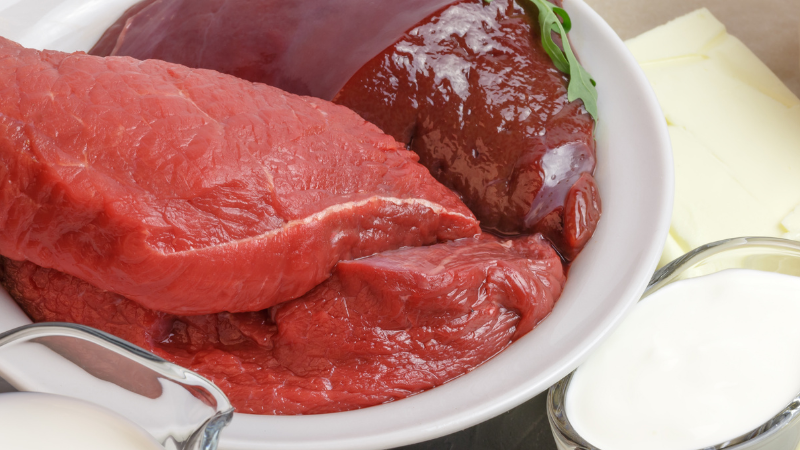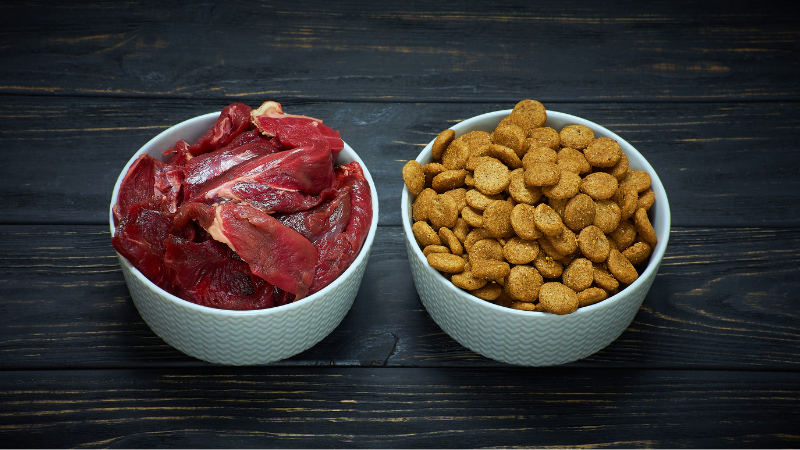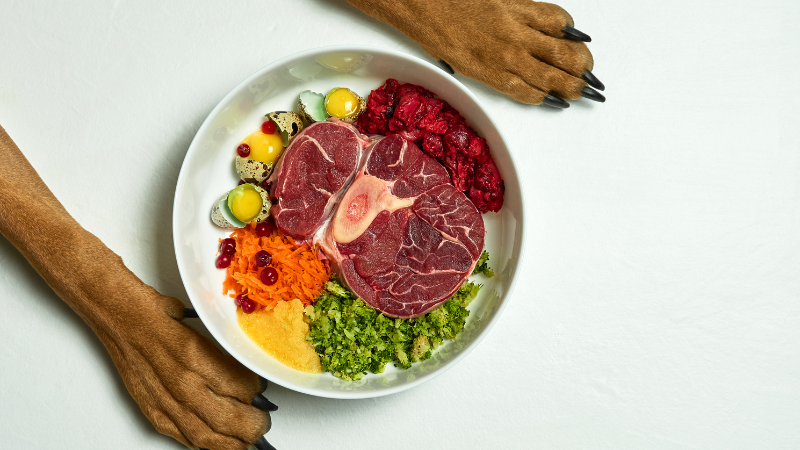How Much Protein is in Dog Food? Exploring Canine Nutrition!

Dogs, our beloved companions, rely on a complete and balanced diet for their overall well-being. Important nutrients play a vital role; among these, proteins stand out as crucial building blocks for their health.
In this insightful exploration, we delve into the heart of the matter, i.e., how much protein is in dog food? And deciphering the significance of protein in dog’s food.
Key Points
- Proteins are essential for dogs, aiding in muscle development, tissue repair, and immune health.
- Protein content varies in dog diets, ranging from 20-30%, and should be tailored to the dog’s unique needs.
- Finding the right balance in protein intake is crucial, as excess or insufficient protein can lead to health issues in dogs.
Understanding the Role of Proteins in Dog Diets
Proteins are indispensable for dogs, serving as the backbone for various bodily functions. They aid muscle development, repair tissues, support immune health, and ensure a glossy coat. Just like humans, dogs require a consistent intake of proteins to thrive.
How Much Protein is Present in Dog’s Food?
The exact amount of protein in a dog’s food can vary widely depending on the brand, formula, and specific product. Dog’s food labels often reflect the proportion of crude protein in dog food.
Generally, high-quality pet foods have a crude protein level of 20–30%; however, this varies by brand and type of food.
It is also essential to contact your veterinarian to establish the right protein content for your dog’s unique needs, as they might vary depending on age, size, breed, and activity level.
Why Focus on Protein?
Proteins are the bedrock of a dog’s diet. Not only do they provide energy, but they also aid in the production of enzymes (for enzymatic reactions) and hormones, fostering a healthy metabolism. For our furry friends, protein isn’t merely a luxury—it’s a necessity for a vibrant life.
Most commercial dog foods have 50-60% carbohydrates and fats against 15–28% protein, according to Dr. Eric (DVM, MS) from EveryPaw.
Brief Overview of the Dog Food Market
The dog’s diet/food industry offers many options tailored to various canine dietary needs, making the selection process exciting and overwhelming for pet owners. Understanding the protein content and crude protein in dog food is crucial, as it directly impacts a dog’s health and satisfaction.
Recent surveys highlight that 80% of dogs prefer real meat or high-protein food as their primary protein source, underscoring the importance of aligning commercial pet foods and food formulations with canine preferences.
Protein Source Along With Percentage of Dogs Preferring
- Real Meat: 80% (high protein food)
- Fish: 12% (high protein food also helps in weight loss)
- Plant-Based: 5%
- Other: 3%

These insights not only shape the market but also empower pet owners to make informed decisions, ensuring their furry companions receive both nutritious and palatable meals. As a responsible pet owner you must opt for high protein for dogs.
By staying aware of these trends, pet owners can navigate the diverse dog food market, providing their dogs with a satisfying and balanced diet tailored to their specific needs.
Protein Types and Content
Primary Protein Sources in Dog Food
Dog food brands predominantly source proteins from animal and plant-based origins. Animal proteins derived from meat, fish, and poultry are highly digestible and packed with essential amino acids.
Plant-based proteins, on the other hand, often come from cereal grains, legumes, and vegetables, offering a vegetarian alternative is a high protein good for dogs with specific dietary needs.
Comparing Animal and Plant-based Proteins
The debate between animal and plant-based proteins in dog food has long been discussed among pet owners and nutritionists.
Historically, animal proteins have been favored in commercial dog foods due to their complete amino acid profiles, essential for a dog’s overall health and development.
These proteins, sourced from meat, poultry, and fish, are highly digestible and provide a rich array of nutrients for dogs, ensuring the necessary building blocks for their bodies.
However, recent years have witnessed significant advancements in the realm of plant-based proteins.
With growing awareness about environmental concerns and pet dietary restrictions, pet food manufacturers have explored innovative plant-based sources. Legumes, lentils, and peas have emerged as high quality alternatives, providing a substantial protein punch.
When carefully formulated, these plant-based proteins can offer dogs a well-rounded nutritional profile, making them suitable for canines with protein restriction or allergies.

High Protein Food Source & Key Features
Animal Based Proteins
- Complete amino acid profiles
- Highly digestible
- Rich in essential nutrients
Plant-Based Protein
- Environmentally friendly
- Suitable for dogs with dietary restrictions
- Allergen-free options available
According to D. L. Harmon (A professor from the Department of Animal and Food Sciences, University of Kentucky, Lexington), “Protein composition improves the accuracy of predicting the metabolizing energy content of dog food brands.”
How Reading Food Labels Helps Ascertain Protein Content
The key to deciphering the protein content lies in reading the labels. Look for specific protein sources like chicken, lamb, or salmon. A high quality dog food label will explicitly state the protein content, ensuring you make an informed choice for your furry companion.

Advantages of Protein-Rich Dog Food
How High Protein Diets Benefit Dogs’ Health and Wellness
Protein-rich diets support dogs in various ways, from maintaining a healthy weight to promoting a lustrous coat. Adequate high quality proteins aid muscle development, ensuring dogs remain active and agile throughout their lives.
Role of Proteins in Dogs’ Growth and Development
For puppies, protein is incredibly vital. It fuels their rapid growth and helps in the formation of strong bones and muscles. Puppies require a protein-rich diet to support their energetic antics and budding development.
Preventive Aspects of Protein-Rich Diets: Fighting Diseases and Conditions
Adequate protein intake can also act preventively, reducing the risk of diseases and conditions such as obesity, diabetes, and specific food allergies. A well-balanced protein diet enhances the immune system, fortifying dogs against various health challenges.
A dog’s protein needs are multifaceted, influenced by many factors such as age, breed, activity level, and overall health.
Understanding these dynamics is essential for providing tailored nutrition. With their high energy expenditure, active dogs and working breeds require elevated protein levels to sustain their vitality and support muscle repair.
On the other end of the spectrum, old dogs, with slowing metabolisms and aging joints, benefit from a different protein balance.
Striking the right equilibrium is paramount, ensuring that the protein intake aligns with the dog’s specific life stage and health requirements.

Recommended Protein Percentage for Dog Life Stages
- Puppies: 22-32% (Need high protein diet)
- Adult Dogs: 18-25%
- Senior Dogs: 25-30% (Need high protein diet)
The Danger of Too Much Protein or Too Little Protein in Dog Food
Finding the delicate balance in protein intake is crucial for a dog’s overall health. Too much protein an extremely high protein dog diet can strain a dog’s kidneys, potentially leading to kidney dysfunction and dehydration.
Conversely, insufficient protein can result in muscle wastage, kidney disease, weakened immune function, and other health complications.
Maintaining the right balance ensures a dog receives the necessary nutrients without overburdening their system, promoting optimal health and well-being.

Consequences of Imbalanced Protein Intake and its Effects
Excessive Protein
- Kidney strain (chronic kidney disease)
- Dehydration
Insufficient Protein
- Muscle wastage
- Weakened immune system
Special Considerations: Puppies, Old, and Dogs with Health Issues
The Increased Protein Needs of Growing Puppies
Puppies, characterized by their boundless energy and rapid growth, necessitate a high protein-rich diet. A balanced, healthy diet for dogs comprising 22-32% protein content supports their growth spurts, ensuring they develop into strong, healthy adults.
Protein is essential for building robust muscles, bones, and tissues, providing the foundation for a vibrant life ahead.
Meeting the Special Protein Requirements of Old Dogs
As dogs age, their metabolism slows down, making weight management and joint health a priority. Senior-specific dog foods, with protein levels ranging from 25-30%, cater to these needs.
High protein diets aid in maintaining muscle mass, supporting aging joints, and ensuring senior dogs enjoy their golden years with vitality and comfort.
Tailoring Protein Intake for Dogs with Renal Issues or Other Health Problems
Dogs with specific health concerns, such as renal issues, require a specialized approach to their diet.
Specialized dog foods, formulated with controlled protein levels, alleviate the burden on their kidneys. These tailored diets enhance their quality of life, promoting overall well-being despite their health challenges.

Choosing the Right Protein-rich Dog Food: Things to Consider
When selecting protein-rich dog food, a one-size-fits-all approach doesn’t work. The market is flooded with many brands, each offering a unique composition.
Pet owners must delve into the specifics, especially the protein content, to make well-informed decisions.
Understanding the nuances ensures that our adult dogs receive the right dog food nutrition and caters to their requirements and preferences.
Dog Food Brands With Respect to Their Dietary Protein Content (%)
Here are some commercial dog food varieties concerning their dietary protein percentage.
1. VICTOR Classic Hi-Pro Plus: 33% (Best dry dog food)
2. Nature’s Logic Canine Chicken Meal: 40% (High protein diet)
3. Diamond Naturals Extreme Athlete Formula: 36% (Another one of the best dry dog food)
Disclaimer: This article is independent and not affiliated with any dog food brands. Our goal is to provide unbiased, science-based information on dog nutrition
Understanding Different Dog Food Brands and Their Protein Content
A crucial step in decision-making is comparing the protein content across different brands. As depicted in the table above, protein percentages vary, influencing the overall nutritional value of the dog food.
Scrutiny of labels allows pet owners to select a brand that aligns with their dog’s specific dietary needs, whether maintaining muscle mass, supporting growth, or addressing health concerns.
How to Select High-Quality Protein Dog Foods?
Opting for high quality, high protein dog food also ensures our furry companions receive optimal nutrition. Researching reputable brands with a history of producing top-notch dog food is essential.
Certifications such as AAFCO (Association of American Feed Control Officials) ensure meeting industry standards. Additionally, customer reviews offer insights into real-life experiences, guiding pet owners toward reliable choices.
Consulting with veterinarians who profoundly understand a dog’s requirements can provide tailored recommendations, further enhancing the selection process.
FAQs About Nutritional Requirements For Dogs
What Happens If a Dog Gets Too Much Protein in Their Diet?
Too much of a good thing can have adverse effects. A dog consuming excess protein, especially if it’s significantly more than their body requires, can strain their kidneys.
This extra protein might lead to kidney issues dehydration, and potentially even contribute to certain kidney diseases over time. Maintaining a balanced dog diet tailored to your dog’s specific needs is essential.
What Is the Ideal Percentage of Protein Content for Dogs of Different Ages/Sizes?
The ideal percentage of protein in dog food varies based on age, size, and activity level. Generally, adult dog food contains around 18-25% protein.
Puppies, however, require a higher percentage, often between 22-32%, to support their rapid growth. On the other hand, senior dogs benefit from a slightly higher protein content, typically around 25%.

Are Certain Animal Proteins Better for Adult Dogs Than Others?
When it comes to animal proteins, not all are created equal. High-quality animal proteins, such as chicken, turkey, and fish, are highly digestible and provide essential amino acids.
These proteins are often found in premium dog foods, ensuring your canine companion receives the best nutrition. Always check the label of pet foods for specific protein sources to ensure your dog gets the best quality.
How Can I Increase the Protein Content in My Dog’s Diet Safely?
Increasing your dog’s protein intake should be done gradually and under the guidance of a veterinarian.
Sudden changes in dog protein supplements can upset their digestive system. You can opt for high-quality dog nutrition with a higher protein content or introduce protein-rich treats and supplements.
However, moderation is key, as an abrupt increase can lead to health issues.
What Are the Signs That My Dog Might Need More Protein?
Observing your dog’s behavior and physical condition can provide valuable insights.
If your dog seems lethargic, has a rough coat, experiences muscle wastage, or lacks enthusiasm for activities, it might indicate a protein deficiency.
Additionally, consult your veterinarian for proper veterinary medicine if you notice unexplained weight loss or a decrease in appetite, as these could also be signs of inadequate protein intake.
How Much Protein Should a Dog Have Daily? Or How Much Protein Does a Dog Need?
On an average dogs need 1g of protein per pound (lb) of body weight every day.
Final Words: Keeping Your Dog’s Unique Needs in Mind
Understanding that every dog’s body is unique is the cornerstone of selecting the right dog food with the right protein percentage.
Tailoring their diet to their specific needs involves a holistic approach that takes into account their age, breed, activity level, and health status.
For instance, an active Border Collie may require higher protein content to fuel their energetic lifestyle. At the same time, a senior Pug may benefit from a blend that supports joint health and maintains a healthy weight.
By tailoring the protein content and overall nutritional composition to these individual factors, pet parents can provide their dogs with a well-rounded and balanced diet for dogs. This personalized approach enhances their health, enabling happy, vibrant lives.
